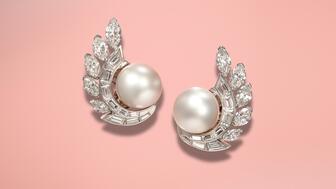The entrepreneur and “Shark Tank” star will share his top tips for success.
1,564 Jewelry Businesses Ceased Operations in 2016
The figure from the Jewelers Board of Trade includes the U.S. and Canada and represents a 64 percent increase over the prior year.

Warwick, R.I.--Year-end statistics from the Jewelers Board of Trade are what we thought they would be.
After rising sharply throughout the year, the number of retail jewelers, wholesalers and manufacturers in the United States and Canada that closed down in 2016 totaled 1,564, compared with 956 in 2015.
That is a 64 percent year-over-year increase.
Breaking it down by category, there were 1,190 retail jewelers in the U.S. and Canada that ceased operations, up 53 percent from 2015; 235 wholesalers, up 81 percent; and 139 manufacturers, up 190 percent.
Including consolidations (sales/mergers) and bankruptcies, the total number of business discontinuances reached 1,718 in 2016, a 54 percent increase over 2015.
In an interview with National Jeweler on Tuesday, JBT President Anthony Capuano said the fact that business discontinuances increased did not surprise him, though end number of closures was slightly higher than expected.
RELATED CONTENT: Demographic Drop-offHe said that the main factor driving the increased rate of closures is that many business owners are at or near the age of retirement, and they are finding themselves at the helm of companies that are no longer as robust as they once were with, in many cases, no next generation waiting to enter the family business.
RELATED CONTENT: What It Feels Like to Close My StoreDuring the interview, Capuano also addressed an online conversation that cropped up following publication of the JBT’s third quarter statistics about jewelers shuttering their stores but remaining in the business either as private, appointment-only jewelers or custom designers.
The commenter felt that the JBT’s numbers for jewelry store closures were inflated because they did not take into account these individuals, but Capuano said they are not.
“That might be some of them, but it’s certainly not 1,190 of them.
“I don’t believe that 1,190 (jewelers) are going to home businesses, or seasonal businesses or part-time businesses. I think the majority of them are just discontinuances,” he said.
He added that even if some jewelers are remaining active in the industry, a store closure “still represents a contraction in the business; they don’t have a reason to open full time in a distinct location.”
New Business Openings
While more companies continue to exit the industry, new business listings have remained relatively flat over the past three years, with the JBT adding about 260 to 290 new jewelry business listings in the
In 2014, there were 261 new jewelry business recorded by the JBT. The following year, that number rose to 289 but fell again in 2016, to 275. The Northeast and the Southeast accounted for the majority of new listings last year.
“There are people willing to take a chance in this business,” Capuano said.
He also noted that retailers accounted for the vast majority of new businesses in the industry last year. There were 218 new jewelers, compared with 43 wholesalers and 18 new manufacturers.
At the end of 2016, JBT’s total listings stood at 27,950: 21,007 retailers, 4,119 manufacturers and 2,824 manufacturers in North America. That is down 6 percent from 2015.
Here are some other trends for 2016, as outlined by the JBT:
--Bankruptcies continued to decline, totaling 34 in 2016 compared to 40 in 2015. (On a comparative note, that number was three times as high around the peak of the financial crisis.)
Capuano said the jewelry industry is not alone in seeing bankruptcies slide, as it is a trend being seen in many industries nationwide. Company bankruptcies as a whole in the U.S. were down 2 percent year-over-year in the first three quarters of 2016, with what filings there were concentrated in the oil, gas and energy exploration industries.
--Business consolidations (mergers and acquisitions) were relatively flat year-over-year, 118 in 2016 vs. 114 in 2015. Capuano said there are fewer interested parties that want to buy a brand, company or a store in a nearby market today.
--Credit rating metrics remained stable, with an upgrade to downgrade ratio of 0.97x at year-end compared with 0.95x at the end of 2015.
--Collection claim activity was down, and so was the size of the average claim, which fell 8 percent to $7,299.
In 2017, Capuano said he expects consolidation to continue. While the rate at which businesses are closing might abate slightly, he does not expect the trend to reverse itself this year.
The Latest

The Ukrainian brand’s new pendant is modeled after a traditional paska, a pastry often baked for Easter in Eastern European cultures.

The jeweler has announced a grand reopening for its recently remodeled location in Peoria, Illinois.

The “Strong Like Mom” campaign features moms who work at Tiffany & Co. and their children.


Interior designer Athena Calderone looked to decor from the 1920s and 1930s when crafting her first fine jewelry collection.

During a call about its full-year results, CEO Efraim Grinberg discussed how the company is approaching the uncertainty surrounding tariffs.

Bench jewelers spend years honing their skills, Jewelers of America’s Certification validates their talents.

The free program provides educational content for jewelry salespeople and enthusiasts to learn or refresh their diamond knowledge.

The feedback will be used to prepare other jewelers for the challenges ahead, the organization said.

The online sessions are designed to teach jewelers to use AI tools like ChatGPT and Claude to grow their business.

The opening marks the jewelry retailer’s first location in the Midwest.

The “United in Love” collection offers tangible mementos of hearts entwined with traditional and non-traditional commitment heirlooms.

Robert Goodman Jewelers will hold a “Black Jewelry Designers and Makers” event on April 27.

The announcements follow a tumultuous start to 2025 for WJA, which saw a wave of resignations following controversial statements about DEI.

Editor-in-Chief Michelle Graff answers questions about how the new taxes levied on countries like India and China will impact the industry.

Kenewendo, Botswana’s minster of minerals and energy, discusses closing the deal with De Beers and the work that was missed along the way.

The historic fancy vivid blue diamond set to headline Christie’s Geneva sale next month could sell for up to $50 million.

LVMH CFO Cécile Cabanis also discussed the effects of tariffs so far.

The “Mad Men” and “The Morning Show” star steals jewelry, art, and handbags from his wealthy neighbors in “Your Friends & Neighbors.”

The organization has reelected Kalpesh Jhaveri as president.

An investigation found that the former managing director of Movado’s Dubai branch overstated and prematurely recorded sales.

The collection pays tribute to the Japanese philosophy of Ma, studying balance, stillness, and the interplay between presence and absence.

Mari Lou’s Fine Jewelry in Orland Park, a suburb of Chicago, is closing its doors.

GIA’s labs in Dubai and Hong Kong are now accepting larger diamonds in light of the “logistical challenges” presented by the new tariffs.

These earrings by Van Cleef & Arpels, featuring the same design as a pair worn by Princess Grace, are up for auction at Woolley & Wallis.

Two experts share how artificial intelligence tools can help retailers run a more efficient business.



























